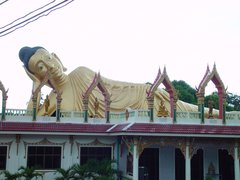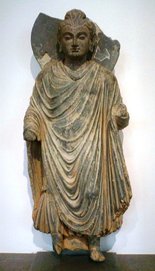Buddha
|
|
- For other uses, see Buddha (disambiguation).
Buddha_image_-_white_stone.jpg
Buddha (Sanskrit, Pali, others: literally Awakened One, Enlightened One, from the Sanskrit: √budh, "to awaken") or "The Buddha" is a title given to anyone who has rediscovered enlightenment (Bodhi), though it is commonly used to refer to "The Buddha" Siddhartha Gautam.
A Buddha is one who rediscovers the Dharma (that is, truth; the nature of reality, of the mind, of the affliction of the human condition and the correct "path" to liberation) by Enlightenment, which comes to be after skillful or good karma (action) is perfectly maintained and all negative unskillful actions are abandoned. Buddhism recognises three types of Buddha, of which the simple term Buddha is normally reserved for the first type, that of Samyaksam-buddha (Pali: Samma-Sambuddha). The attainment of Nirvana is exactly the same, but a Samyaksam-buddha expresses more qualities and capacities than the other two.
| Missing image Dharma_wheel_1.png Dharma wheel Buddhism |
| Culture |
| History |
| List of topics |
| People |
| By region and country |
| Schools and sects |
| Temples |
| Terms and concepts |
| Texts |
| Timeline |
Generally, Buddhists do not consider Siddhartha Gautam, who lived from about 623 BCE to 543 BCE attaining enlightenment around 588 BCE, to have been the first or last Buddha. From the standpoint of classical Buddhist doctrine, the word Buddha denotes a type of person of which there have been many in the course of cosmic time. Hence the Gautam Buddha is one member of a spiritual lineage of Buddhas going back to the dim past and forward into the distant future ,who among the rest is the most recognized and followed,being him the only documented one.He was born in Lumbini in the Himalayan Kingdom of Nepal.
According to Buddhist tradition, Siddhartha Gautam ("One who has attained an aim or object" Monier-Williams (http://students.washington.edu/prem/mw/s.html)) did not claim any divine status for himself, nor did he assert that he was inspired by any god. He claimed to be a teacher to guide those who chose to listen, rather than a personal saviour. Gautam Buddha stated that there is no intermediary between mankind and the divine; distant gods are subject to karma themselves in decaying heavens. The Buddha is solely an exemplar, guide and teacher for those sentient beings who must tread the path themselves, attain spiritual Awakening, and see truth and reality as they are.

The Awakened bliss of Nirvana, according to Gautam Buddha, is available to all beings —although orthodoxy holds that one must first be born as a human being. Emphasizing this universal availability, the Mahayana school of Buddhism in particular refers to many Buddhas and also to many bodhisattvas (beings committed to Enlightenment but who vow to postpone their own Nirvana in order to assist others on the path). In the holy Tripitaka - the core sacred texts of Buddhism - the numerous past Buddhas and their lives are spoken of, along with the next Buddha-to-be, who is named Maitreya.
Eternal Buddha
The idea of an everlasting Buddha is a Mahayana notion popularly associated with the Mahayana Buddhist scripture, the Lotus Sutra. That sutra has the Buddha indicate that he became Awakened countless, immeasurable, inconceivable myriads of trillions of aeons ("kalpas") ago and that his lifetime is "forever existing and immortal". From the human perspective, it seems as though the Buddha has always existed. The sutra itself, however, does not directly employ the phrase "eternal Buddha"; yet similar notions are found in other Mahayana scriptures, notably the Mahaparinirvana Sutra, in which the Buddha presents himself as the eternal ("nitya"/ "sasvata"), unchanging, blissful, pure Self (Atman) who, as the Dharmakaya, knows of no beginning or end. The All-Creating King Tantra additionally contains a panentheistic vision of Samantabhadra Buddha as the eternal, primordial Buddha, the Awakened Mind of bodhi, who declares: "From the primordial, I am the Buddhas of the three times [i.e. past, present and future]." The notion of an eternal Buddha perhaps finds resonance with the earlier idea of eternal Dharma/Nirvana, of which the Buddha is said to be an embodiment.
Buddha statues
Buddhas are frequently represented in the form of statues. Commonly seen designs include:
- Seated Buddha, as in the above Tang Dynasty Amitabha sculpture
- Reclining Buddha, as shown to the right
- Standing Buddha, as shown below
- Hotei, the obese, laughing Buddha, usually seen in China. This figure is generally considered to be a representation of either a medieval Chinese monk or of Maitreya, the future Buddha, and is therefore not technically a Buddha image.
Most depictions of Buddha contain a certain number of markings, which are considered the signs of his enlightenment. These signs vary regionally, but three are common:
- A protuberance on the top of the head (denoting superb mental accuity)
- Long earlobes (denoting superb perception)
- A third eye (also denoting superb perception)
The poses and hand-gestures of these statues, known respectively as asanas and mudras, are significant to their overall meaning. The popularity of any particular mudra or asana tends to be region-specific, such as the Vajra (or Chi Ken-in) mudra, which is popular in Japan and Korea but rarely seen in India. Others are more universally common, for example, the Varada (Wish Granting) mudra is common among standing statues of the Buddha, particularly when coupled with the Abhaya (Fearlessness and Protection) mudra.
Sources
- The Threefold Lotus Sutra (Kosei Publishing, Tokyo 1975), tr. by B. Kato, Y. Tamura, and K. Miyasaka, revised by W. Soothill, W. Schiffer, and P. Del Campana
- The Mahayana Mahaparinirvana Sutra (Nirvana Publications, London, 1999-2000), tr. by K. Yamamoto, ed. and revised by Dr. Tony Page
- The Sovereign All-Creating Mind: The Motherly Buddha (Sri Satguru Publications, Delhi 1992), tr. by E.K. Neumaier-Dargyay
See also
- The Buddha and His Dhamma (http://www.columbia.edu/itc/mealac/pritchett/00ambedkar/ambedkar_buddha/)
- Trikaya
- List of founders of major religions
- Buddha Statues of Bamiyan
- Buddha-nature
- Tathagatagarbha
- Atman (Buddhism)
- God in Buddhismbg:Буда
da:Buddha de:Buddha es:Buda eo:Budho fr:Bouddha ko:부처 ms:Buddha nl:Boeddha id:Buddha ja:仏陀 jv:Buddha pl:Budda pt:Buda ro:Buddha ru:Будда sl:Buda sr:Буда sv:Buddha th:พระพุทธเจ้า tpi:Buda uk:Сиддхартха Гаутама Будда zh:佛


